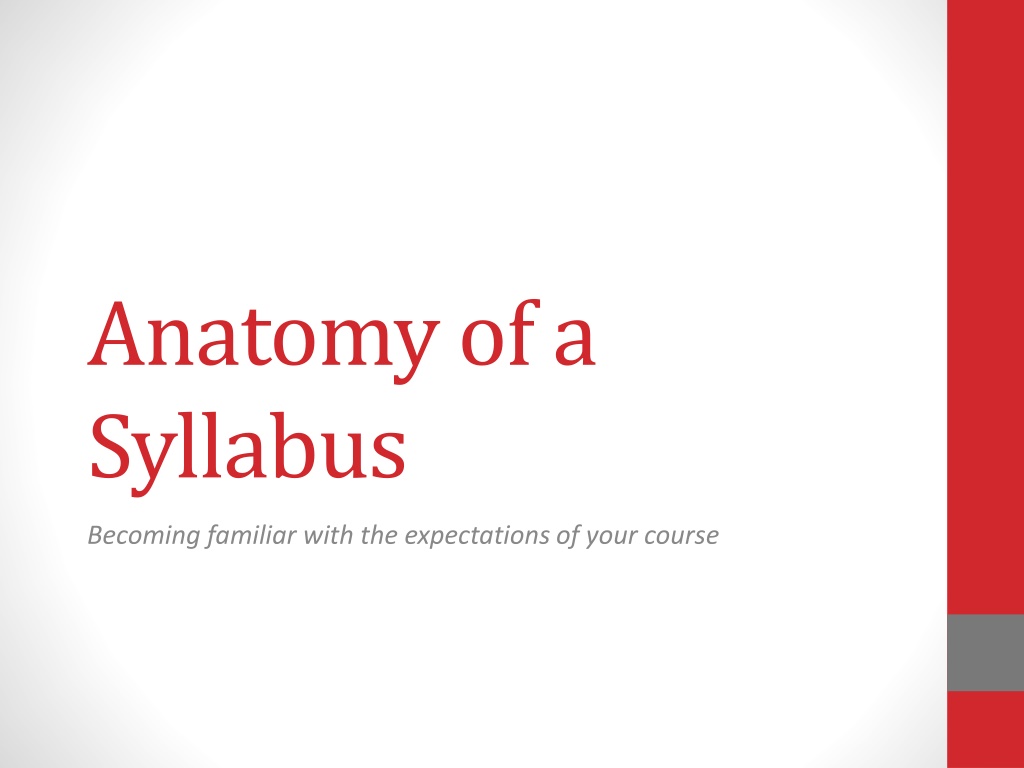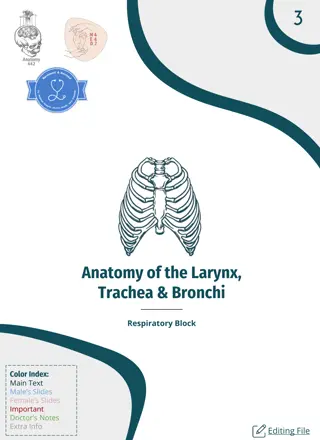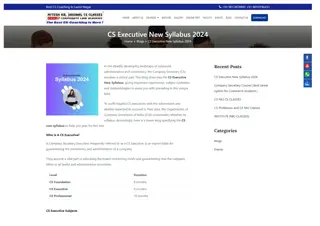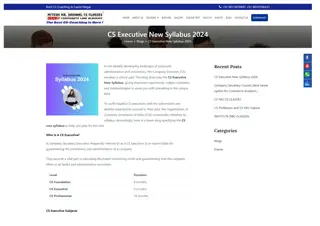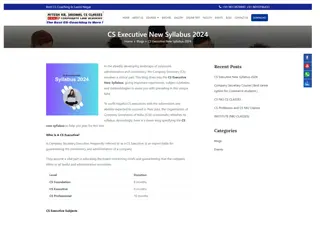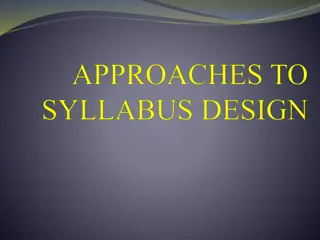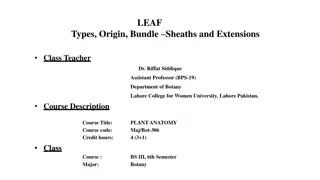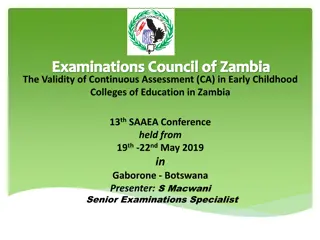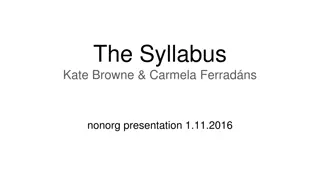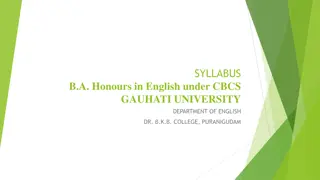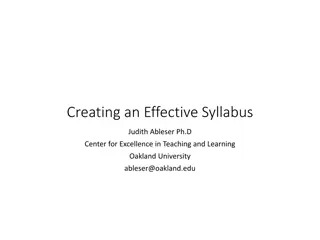Understanding the Anatomy of a Syllabus
Learn about the purpose of a syllabus, what it includes, and how to navigate it effectively. Get insights on what a syllabus is, what it is not, and valuable advice from advisors on making the most of this essential course document. Explore the key components of a syllabus and understand the significance of course descriptions in shaping your academic journey.
Download Presentation

Please find below an Image/Link to download the presentation.
The content on the website is provided AS IS for your information and personal use only. It may not be sold, licensed, or shared on other websites without obtaining consent from the author. Download presentation by click this link. If you encounter any issues during the download, it is possible that the publisher has removed the file from their server.
E N D
Presentation Transcript
Anatomy of a Syllabus Becoming familiar with the expectations of your course
What a syllabus is A guide to the academic content (topics) and skills you will be introduced to, and when you will have opportunities to practice them A document that states the academic and dispositional requirements and expectations of the course A contract between you and your professor
What a syllabus is not An agreement that you can negotiate with your professor A document that you read carelessly or ignore, and at the end of the course, say that I didn t know I had to ________ or Nobody explained that I was required to _________.
Advice from advisors Read your syllabus carefully, and read it more than once. Ask your professor questions about any part of the syllabus you don t understand. Transfer important dates and assignments from the syllabus to your planner. Learn to work backwards . If you have an assignment due on October 13, when will you need to begin working on it to have a good outcome? Accept the reality that coursework often takes longer than you expect it to. Build in extra time for assignments.
The parts of a syllabus Course number, section number, course title Semester Day and time of class meetings Name of professor/instructor Office hours Professor/instructor contact email Course description Learning outcomes (sometimes called course objectives) Required books and other texts Assessment and course requirements (how your professor will evaluate what you have learned in the course) Policies: attendance and lateness, academic integrity, services for students with disabilities, use of cell phones and other electronic devices, eating in class Class schedule
Course description Provides an overview of what the course will explore and often identifies the academic discipline(s) it is situated within This course will provide an overview of the field of developmental disabilities with a perspective that is interdisciplinary and practical. (Introduction to Developmental Disabilities) Identifies perspectives and theoretical approaches that will be used and emphasized We will look at these contributions through the social and political context of American culture from the period of slavery to the present and through a lens of gender, race, class, and sexuality. (African American Women s History) Identifies specific academic skills to be developed The course emphasizes critical reading, thinking, and writing skills as well as various theoretical approaches to the composition of the academic essay. (Core Humanities 1)
Learning outcomes What will you be able to do by the end of the course? Students will be able to read critically, with close attention to the language of the text. (Core Humanities 1) Students will be able to isolate main ideas and theses, both explicit and implicit, recognize argumentation structures, and recognize and use effectively a number of common rhetorical devices. (Core Humanities 1) Students will be able to describe the existing and evolving service systems in New York and the implications for families and planning for family members with disabilities. (Introduction to Developmental Disab.) Students will be able to periodize and contextualize some of the defining epochs and eras of the modern, western, intellectual and cultural tradition, from the early modern era to the Scientific Revolution, the Renaissance, and the Enlightenment, up to and including the Modern and Postmodern periods. (Introduction to Interdisciplinary Studies)
Engaged learning requires being active, not passive Prepared doing assignments thoroughly and on time; coming to class with readings done; participating in discussions based on the readings Informed becoming knowledgeable about the vocabulary and terminology, facts, questions, debates of the subject matter; using tools such as dictionaries, glossaries, maps, etc. Critical learning how to identify the author s argument, to ask questions of the texts, examining texts for evidence that supports the author s argument, to evaluate the soundness of the argument Tolerant being patient with the process of learning; accepting one s mistakes and learning from them; accepting that learning takes time
Required books and other texts Consider the required books, articles, and other texts your work equipment if you don t have your tools, you can t do the job! What are your options in addition to purchasing the book? CWE Library Cohen Library on the main campus Other CUNY libraries Google Books Former students
Assessment and course requirements How will the professor evaluate what you have learned? An introductory essay, plus five formal essays of at least 750 words, each revised once, are required. Essays will be graded only after revision. The averaged grades of these five essays will comprise two-thirds of your final grade. Attendance and participation account for on-third of your final grade. (Core Humanities 1) Quizzes: 40%. There will be 13 quizzes. Presentation: 15% Reaction paper to 1491: New Revelations of the Americas Before Columbus 15% Final paper: 30 % (Latin American and Caribbean Civilization) Ethnographic Exercise: Gender Socialization (due Oct 16) This 2-3 page-paper requires doing fieldwork in a toy store, play ground, or any setting in which you might observe adult-child interactions. Observe and analyze how gender norms, roles, and ideals are reflected and reproduced through toys, consumer goods, and socialization. How are gender roles communicated to children? What messages about race, class, and consumption are conveyed to children? (Cross-Cultural Perspectives)
Grading At the discretion of each professor, who is considered the classroom expert in her or his field Your final grade gives you an overall impression of your progress in the course. However, it does not necessarily enable you to identify the particular skills you may still need to master. The takeaway: ALWAYS carefully read the professor s comments on any assignment. Ask for feedback. Meet with your professor during office hours to deepen your understanding of your performance on an assignment. Then, IMPLEMENT your professor s suggestions.
Policies Ensure a fair and orderly learning experience for all students Adhere to the academic rules and regulations of City College Promote intellectual integrity it is unethical to steal the work of others Provide a level playing-field for students with disabilities (adherence to Federal and State law) Create a respectful, orderly, physically and emotionally safe environment that is conducive to the exchange of ideas and the development of students abilities Every syllabus includes general policies that apply to every course at CWE and the specific policies of that professor.
Class Schedule Tells you the pace of the class What will you explore? What is the sequence of work? When are assignments due?
Your syllabus is a road map Use it wisely, and enjoy your journey!
